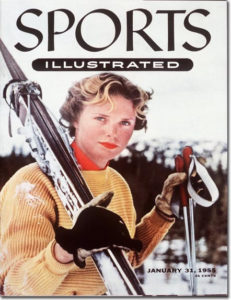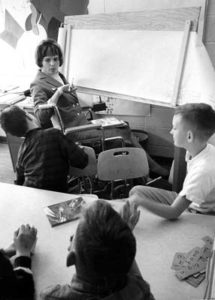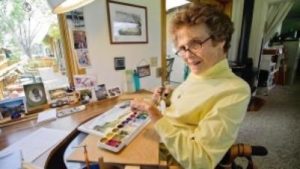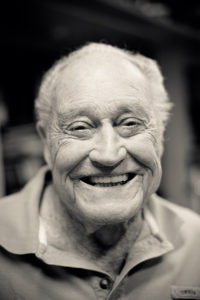By Suzanne Sparrow Watson
 Here I am, once again in the middle of summer in Scottsdale where the average temperature rivals the inside of my oven. It’s actually been okay this year, partly because I’ve had a lot of projects to keep me busy and partly because I ran into a person with a shitty attitude at the gym. Nothing makes me more irritated than people who endlessly whine and complain. So when I met up with a woman who went on and on…and on…about how hot the weather was I looked her in the eye and said, “It’s all in your attitude”. I have been thinking about attitude and approach these past couple of weeks. On our visit to Mammoth lakes we re-visited the Mammoth Museum where I reflected on the tributes to Jill Kinmont. It was Jill – or at least a book about her – that first taught me about a positive approach to life.
Here I am, once again in the middle of summer in Scottsdale where the average temperature rivals the inside of my oven. It’s actually been okay this year, partly because I’ve had a lot of projects to keep me busy and partly because I ran into a person with a shitty attitude at the gym. Nothing makes me more irritated than people who endlessly whine and complain. So when I met up with a woman who went on and on…and on…about how hot the weather was I looked her in the eye and said, “It’s all in your attitude”. I have been thinking about attitude and approach these past couple of weeks. On our visit to Mammoth lakes we re-visited the Mammoth Museum where I reflected on the tributes to Jill Kinmont. It was Jill – or at least a book about her – that first taught me about a positive approach to life.
Jill Kinmont was an accomplished ski racer from Bishop, California in the early 1950’s. She skied on the Mammoth Mountain team, coached by Dave McCoy (see my previous post about him). To say that Jill was a sensation is an understatement. She was one of the brightest American prospects for the 1956 Olympic team. In addition, she was the very embodiment of mid-century good looks – blonde hair, blue eyes and a perky personality. In January, 1955 she was featured on the cover of Sports Illustrated, and tragically was one of the worst examples of the “SI curse”. The same week that her cover was published she fell on a run during the Snow Cup in Alta, Utah and broke her neck. She was paralyzed from the neck down and the doctors told her family that she would only live another five years. At 18, her life as she knew it was over. But friends like fellow ski racer Andrea Mead Lawrence and Dave McCoy urged her not to accept that prognosis. Jill, being a natural competitor, was determined to make a life for herself. She insisted that she was going to walk – and ski – again. She was never able to accomplish those goals but the remainder of her life was lived in a way that is a lesson to us all.
Despite being confined to a wheelchair, she had the use of neck and shoulder muscles and learned to write, type and paint with the aid of a hand brace. She applied to UCLA and graduated with a degree in German and English. But when she applied to the university’s school of education she was rejected because of her disability. Undaunted, she moved north with her parents, earned a teaching certificate at the University of Washington and taught remedial reading in elementary schools on Mercer Island.
When she and her mother returned to Los Angeles after her father died in 1967, one Southern California school district after another refused to hire her. Finally, the Beverly Hills District employed her as a remedial reading teacher where she taught for several years. She spent her summers back in Bishop teaching children at the Paiute Indian reservation. In 1975 she and her mother moved back to Bishop where she was hired and spent the next 21 years with special needs kids at Bishop Union Elementary School. When a new high school opened in Bishop, the students voted to name it the Jill Kinmont Boothe School. She oversaw the Indian Education Fund, which provides scholarships to local Native American youth, and had a local following as a painter. The proceeds from her art sales were donated to the scholarship fund.
As if her physical injuries weren’t enough Jill also had to endure losses in her romantic life. At the time of her injury she was dating the skiing phenom Buddy Werner. After her accident he couldn’t handle her injured state and broke off their relationship. He died a few years later in an avalanche. She then dated and became engaged to daredevil skier Dick “Mad Dog” Buek but before they could marry he died in a small plane crash. All that tragedy in one life is almost unimaginable. But luck was finally on her side when she met John Boothe in Bishop. They were married in 1976 and they lived a wonderful life until her death in 2012.
I first learned about Jill Kinmont’s story in 1969 when someone gave me a copy of “A Long Way Up”, the story of her life to that point. The book was subsequently made into a popular movie, “The Other Side of the Mountain”. Her story was so inspiring that I’ve often thought about her during tough times. Her spirit and attitude provide a positive and upbeat touchstone. I wish I had 100 copies of her book because in my fantasy life here’s what I’d do with them: when someone complains endlessly about 105 degree weather, I’d shove Jill’s book in their face and tell them to get a life. Or, perhaps, I would quote Jill herself, who told the LA Times when they named her Woman of the Year in 1967, “To get mad, to scream and holler, to tell the world off— that doesn’t get you anywhere. You look for what’s good that’s left, I guess.”






